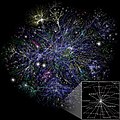The Barabási–Albert (BA) model is an algorithm for generating random scale-free networks using a preferential attachment mechanism. Several natural and...
21 KB (2,744 words) - 11:12, 6 February 2025
Harvard University. In 1999 Barabási discovered the concept of scale-free networks and proposed the Barabási–Albert model, which explains the widespread...
40 KB (4,111 words) - 13:58, 29 March 2025
Bianconi–Barabási model is named after its inventors Ginestra Bianconi and Albert-László Barabási. This model is a variant of the Barabási–Albert model. The...
22 KB (3,121 words) - 19:54, 12 October 2024
Scale-free network (redirect from Generalized scale-free model)
PMID 11005838. Barabási, Albert-László (2004). Linked: How Everything is Connected to Everything Else. Perseus Pub. ISBN 0-452-28439-2. Barabási, Albert-László;...
47 KB (6,013 words) - 05:15, 12 April 2025
University of Notre Dame in 2001. Albert is co-creator, together with Albert-László Barabási, of the Barabási–Albert model for generating scale-free random...
8 KB (666 words) - 07:14, 3 May 2025
preferential attachment family of models, such as the Barabási–Albert (BA) model. (On the other hand, the Barabási–Albert model fails to produce the high levels...
11 KB (1,613 words) - 14:01, 15 May 2025
social networks. Some modeling alternatives include Barabási–Albert model and Watts and Strogatz model. These alternative models are not percolation processes...
19 KB (2,795 words) - 05:56, 9 April 2025
in effect, makes the Watts–Strogatz model a random network. The Barabási–Albert model is a random network model used to demonstrate a preferential attachment...
69 KB (9,906 words) - 05:34, 12 April 2025
more recent Barabási–Albert model is that the Price model produces a graph with directed edges while the Barabási–Albert model is the same model but with...
9 KB (1,565 words) - 14:21, 14 April 2025
hierarchical models nodes with more links are expected to have a lower clustering coefficient. Moreover, while the Barabási-Albert model predicts a decreasing...
9 KB (1,192 words) - 03:30, 26 March 2024
random networks. Scale-free networks (Barabási–Albert model) are different from random networks (Erdős–Rényi model) in two aspects: (a) growth, (b) preferential...
11 KB (1,450 words) - 16:04, 5 January 2025
Bianconi and Albert-László Barabási proposed a new model called Bianconi-Barabási model, a variant to the Barabási-Albert model (BA model), where the probability...
6 KB (863 words) - 15:34, 13 November 2023
networks, the uniform-preferential-attachment model, or UPA model is a variation of the Barabási–Albert model in which the preferential attachment is perceived...
5 KB (1,044 words) - 13:27, 3 March 2024
Node deletion (section Barabási-Albert model)
so the diameter goes up. Barabási, A.-L. NETWORK SCIENCE, Cambridge University Press 2015 Albert, R.; Jeong, H.; Barabási, A.L. Error and attack tolerance...
5 KB (766 words) - 12:14, 6 November 2023
widely known generative models for scale-free networks are stochastic, such as the Barabási–Albert model or the Fitness model can reproduce many properties...
5 KB (819 words) - 22:43, 17 March 2025
hypercubes. Some models of growing networks that produce scale-invariant degree distributions are the Barabási–Albert model and the fitness model. In a network...
19 KB (2,448 words) - 15:52, 5 January 2025
relatively well described by a lognormal distribution, as well as the Barabási–Albert model for power laws. The webgraph is an example of a scale-free network...
5 KB (492 words) - 05:51, 2 April 2025
most two, and the Apollonian networks have degeneracy three. The Barabási–Albert model for generating random scale-free networks is parameterized by a...
31 KB (3,769 words) - 02:53, 17 March 2025
attractiveness is a possible extension of the Barabási–Albert model (preferential attachment model). The Barabási–Albert model generates scale-free networks where...
7 KB (1,002 words) - 19:56, 12 October 2024
version of the Price model, the Barabási–Albert model. However, since Price's model gives a directed acyclic graph, it is a useful model when looking for...
45 KB (5,646 words) - 20:41, 12 May 2025
to the growth of the World Wide Web was proposed by Barabási and Albert in 1999. Barabási and Albert also coined the name "preferential attachment" by which...
14 KB (1,778 words) - 23:06, 20 May 2025
to that limit distribution. In the context of random graphs, the Barabási–Albert model also exhibits an asymptotic degree distribution that equals the...
10 KB (1,312 words) - 03:48, 11 June 2023
community structure. Many basic network models, for example, such as the random graph and the Barabási–Albert model, do not display community structure....
37 KB (4,591 words) - 20:57, 1 November 2024
as models to understand seizures. Barabási–Albert model – Scale-free network generation algorithm Climate as complex networks – Conceptual model to generate...
38 KB (4,646 words) - 01:15, 11 April 2025
deviation principle Varadhan's lemma Random graph BA model Barabási–Albert model Erdős–Rényi model Percolation theory / phs (L:B) Percolation threshold /...
35 KB (3,026 words) - 12:15, 30 October 2023
calculated analytically for two models of networks: the random graph of Erdős and Rényi BA Model (Barabási-Albert model) In the ER model, since edges are placed...
13 KB (1,976 words) - 11:43, 15 March 2024
phenomena in economics. In their first model, known as the Barabási–Albert model, Barabási and Albert (BA model) choose Π ( i ) = k i ∑ j = 1 k j {\displaystyle...
13 KB (1,915 words) - 05:18, 12 April 2025
Furthermore, if the substrate network G is scale-free, like in the Barabási–Albert model, then the gradient network also follow the power-law with the same...
12 KB (1,512 words) - 05:19, 10 January 2024
replication Balding–Nichols model Banburismus – related to Bayesian networks Bangdiwala's B Bapat–Beg theorem Bar chart Barabási–Albert model Barber–Johnson diagram...
87 KB (8,280 words) - 23:04, 12 March 2025
multilayer and higher-order networks, and in particular for the Bianconi–Barabási model of growing of complex networks and for the Bose–Einstein condensation...
6 KB (451 words) - 12:04, 20 May 2025













